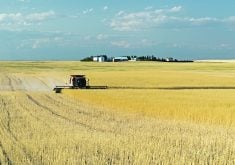Pity the family farmer. Once a shining centrepiece of Canada’s economic growth, our farmers are little more than an afterthought in our urban-focused world.
And the federal government, which once supported small farms through helpful policies, is landing a new and devastating blow through federal capital gains tax changes.
The planned changes will make it costlier and harder to sell or pass farms to new generations.
Read Also

Growth plates are instrumental in shaping a horse’s life
Young horse training plans and workloads must match their skeletal development. Failing to plan around growth plates can create lifelong physical problems.
Between 1941 and 2021, the number of farms in Canada fell by approximately 75 percent. People have left farms because the workdays are long and hard, the capital investment is ever-larger and the margins are narrow. Most people could make more money by taking the cash tied up in land and equipment and playing the market instead.
Large farms now dominate. Just 10 percent of all farms now generate more than two-thirds of the sales in Canada. These farms are large-scale businesses with multiple employees, thousands of acres and millions of dollars in equipment. Some are still owned by family groups but many are owned by corporations.
Now, capital gains over $250,000 are subject to a new 66.67 percent inclusion rate for individuals, and all capital gains generated through a corporation are also subject to this rate. Although the lifetime capital gains exemption for eligible property has increased from $1 million to $1.25 million, the benefit of this exemption is largely negated by the sharp rise in property values.
“With over 40 percent of farmers nearing retirement over the next decade, this tax increase introduces substantial uncertainty into their retirement planning,” said Andre Harpe, chair of Grain Growers of Canada and an Alberta-based grain grower. The changes “will actually burden the next generation of farmers, who are already grappling with costly transfers.”
The GCC has studied what the federal tax changes will mean to farmers. It calculates that an 800-acre farm purchased in 1996 in Ontario would incur nearly $1.2 million in additional taxes if sold today. A 4,000-acre farm in Saskatchewan would face an increase of more than $900,000. That’s a 30 percent spike in capital gains taxes on family-run grain farms.
The GGC has asked the government to exempt intergenerational transfers and allow them to be taxed at the original capital gains inclusion rate.
There are important reasons why family farms deserve our support. In a world of insecurity, it makes sense to ensure we avoid becoming over-reliant on food imports, lest those suppliers one day decide to cut us off.
Which brings us back to federal policy. Most farmers will tell you that, while the loss of rail subsidies and other incentives has hurt, they know how to make a living. Today, many of Canada’s big farms are run by corporations composed of family members educated in best agricultural and business practices.
What they don’t need is a cash-squandering federal government imposing new levels of taxation that hobble the transition to the next generation of family farmers. They need the feds to get out of the way and let the farmers operate as efficiently as possible in a narrow-margin business.
Finance Minister Chrystia Freeland grew up on an Alberta farm and should know that. But then, she serves a government that has allowed spending to run so far amok it has to tax citizens more and more just to stay afloat.
Farmers would go broke if they spent like the federal government does. Fortunately, they don’t.
Doug Firby previously worked as editorial page editor at the Calgary Herald. This article originally appeared on the Troy Media website. It has been edited for length.















